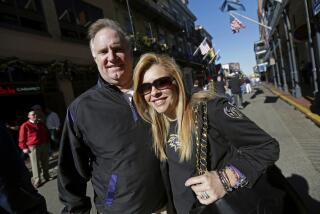HUEY LEWIS--A MR. NICE GUY MAKES NEWS
OAKLAND — “Isn’t he just drrreeeeeeaammmmmy?,” a pretty young woman gushed to her friend, backstage at the Oakland Coliseum Arena on a recent afternoon.
Everyone standing near them heard her. The guy they were drooling over, singer Huey Lewis--wandering through the crowded hallway after a sound check--probably heard her too.
The gushing fan seemed ready to leap on Lewis as he strolled by, looking casual--as usual--in a T-shirt, jeans and a jean jacket. Her friend restrained her.
“Hi,” said Lewis to the pair, as he kept walking.
Both were too stunned to reply.
After he walked by, they recovered instantly. “Let’s get his autograph,” said one of the starry-eyed duo.
“Aw, he won’t sign,” griped the other.
“Sure, he will,” interjected a man--a member of the crew, apparently--standing next to them. “He’s the nicest guy around. He’ll do anything for fans. I think he takes ‘nice’ pills. Nobody can be that nice naturally. The guy is unreal.”
Encouraged, the pair raced after him but he walked into the press room and closed the door.
“We’ll wait,” one of them said with determination.
“I really love his music, don’t you?,” the other asked.
“I don’t listen to his albums,” her friend noted lustfully. “I just like to look at him.”
Lewis was doing some interviews that afternoon to promote his tour, which includes Monday and Tuesday shows at the Forum, and this new album, “Fore!”
In the press room, he was absent-mindedly eating peanuts from a bowl on the coffee table. Everyone else was racing around madly but Lewis was perfectly cool. Though he was due on stage in a few hours, Lewis looked relaxed enough to fall asleep. His looseness is legendary. He’s raised being laid-back to the level of art.
Unlike some younger rockers--like Duran Duran members and Bon Jovi--he’s no pretty boy. Lewis, 36, is rugged, square-jawed handsome, with a face suitable for a GQ magazine cover (he’s on the cover of this month’s issue) and the kind of deep, gravelly voice that women love. He’s the Marlboro Man of rock ‘n’ roll. That’s what many of his female fans, like the two who were lurking outside the door, respond to.
Lewis is a model celebrity. He loves chatting with fans and signing autographs. Show him a line of autograph hounds and he’ll sign until his fingers ache.
“I’m a ham, an extrovert,” he said. “I enjoy the attention. I wouldn’t be in this business if I didn’t like that part of it.”
But then he qualified that statement. “Being a celebrity is tough. Ninety-nine percent of the time, it’s fine. But that one percent can drive you crazy. That’s when you’re fighting with your wife or you’re in one of those I-hate-the-world moods and some guy wants an autograph. You can’t cuss him out. You grit your teeth and do it.
“But sometimes I lose it. Then I’m not so nice. That’s right, me--Mr. Nice Guy. I’m beat and I’m tired and I don’t want to be bothered.”
Celebrity, as Lewis has discovered these last few years, is the baggage that comes with selling millions of records and selling out arenas. While he basks in the recognition and glory, he’s wise enough to be wary of the dark side of celebrity.
“I don’t want to change,” he said. “I don’t want to be like those obnoxious stars with heads three sizes too big. These people swallow this fame business completely. They believe all praise. They actually believe they’re the greatest. But I fight it.
“I like who I was before fame turned my life upside down. I was an OK guy--I still am, I guess. But sometimes it seems like a losing fight. My head swells. Then it swells some more. I say, ‘Damn, this shouldn’t be happening . . . get yourself together, man. You don’t want to be like this one or that one.’ That stops the swelling--usually.”
“Sports,” a Chrysalis album released September, 1983, turned Lewis and his band, the News, into a supergroup. That album, featuring four hit singles--”I Want a New Drug,” “Heart and Soul, “If This Is It” and “Heart of Rock ‘n’ Roll”--has sold 9 million so far.
Many critics called “Sports” a mishmash of lightweight pop-rock. Tuneful, yes, but they charged, without appreciable substance. The “Where’s the beef?” slogan was popular in 1984 when “Sports” was red-hot. In discussing the album, critics often raised that snide question.
“Sports” was such a smash that Lewis was able to tour for two years without a new album. But he and the band didn’t really need a new album. Their participation in the “We Are the World” single and album, and their No. 1 single, “The Power of Love,” from the “Back to the Future” sound track, kept the band’s name alive in 1985.
Making the follow-up to “Sports” was difficult--for all the obvious reasons. “How do you follow a record that sells 9 million?” Lewis asked. “The hell if I knew. We had tapped into something with ‘Sports,’ but we didn’t know what. A big record like that is a curse. You can’t ever follow it with something bigger. The pressure was on. I didn’t really want to do another record. I was going to wait until the pressure let up. But I saw it wasn’t going to let up. Finally we couldn’t wait any longer.”
The success of Lewis’ current album, “Fore!,” has surprised the skeptics who swore Lewis couldn’t follow “Sports” with another big hit. Already, with the help of two Top 10 singles--”Stuck on You” and “Hip to Be Square”--it’s sold two million.
Like “Sports,” “Fore!” was done in a wildly eclectic style. “Blending musical styles is exciting to me,” Lewis admitted. “Put in a little rock, soul, country and anything else that fits and we get a hot, tasty musical sauce. We put in all those musical influences and somehow it turns out right.”
Though originally a New Yorker, Hugh Cregg III calls the San Francisco Bay Area his adopted home. He’s so associated with it that no doubt many residents would swear he’s a native.
A former hippie, hot baseball prospect and a college dropout (from Cornell University), Lewis ventured seriously into music in the ‘70s with a Bay Area bar band called Clover. He started as a harmonica player but gradually switched to singing--against the advice of record company “experts.”
“They said I didn’t have the kind of voice that could be on the radio,” Lewis recalled with a chuckle. “They said you needed a clear, soaring tenor voice. Forget it. This voice is as far from that as you can get.”
But the late ‘70s punk invasion shattered the rock rules. The only rule was anything goes. Lewis’ vocals--high on feeling but low on range and clarity--were suddenly good enough. Lewis and keyboards player Sean Hopper left Clover in 1979 and eventually joined guitarist Chris Hayes, drummer Bill Gibson, sax player Johnny Colla and bassist Mario Cipollina to form the News, which started recording for Chrysalis in 1980.
Lewis, who could easily be a solo star, has been fiercely loyal to this band, which is still intact after all these years. “I love being in a band,” he explained. “Being in a band is all I ever wanted. Just being in a band seemed like the coolest thing in the world.”
At first, Lewis and the band didn’t click commercially. Harshly assessing the band’s debut album, “Huey Lewis and the News,” he said, “We didn’t know how to make records. I wasn’t singing very well then.”
The next album, “Picture This” (1982)--which included the Top 10 single, “Do You Believe in Love”--was much better. The public thought so too. That eclectic bar-band style was a little more polished and commercial.
“This is the greatest bar band around,” Lewis proudly insisted.
Shortly after the interview, Lewis and the News walked on stage of the sold-out Oakland Coliseum Arena. The way the crowd was screaming and yelling, you would have thought the Boss himself was up there.
Their music, augmented by the formidable Tower of Power horns, wasn’t complex or provocative, but it certainly roused that crowd--which obviously wasn’t looking for “deep” music. It was like being in a giant bar listening to some funky, casual musicians.
Like the man said, Huey Lewis and the News is the greatest bar band around.
More to Read
Go beyond the scoreboard
Get the latest on L.A.'s teams in the daily Sports Report newsletter.
You may occasionally receive promotional content from the Los Angeles Times.










